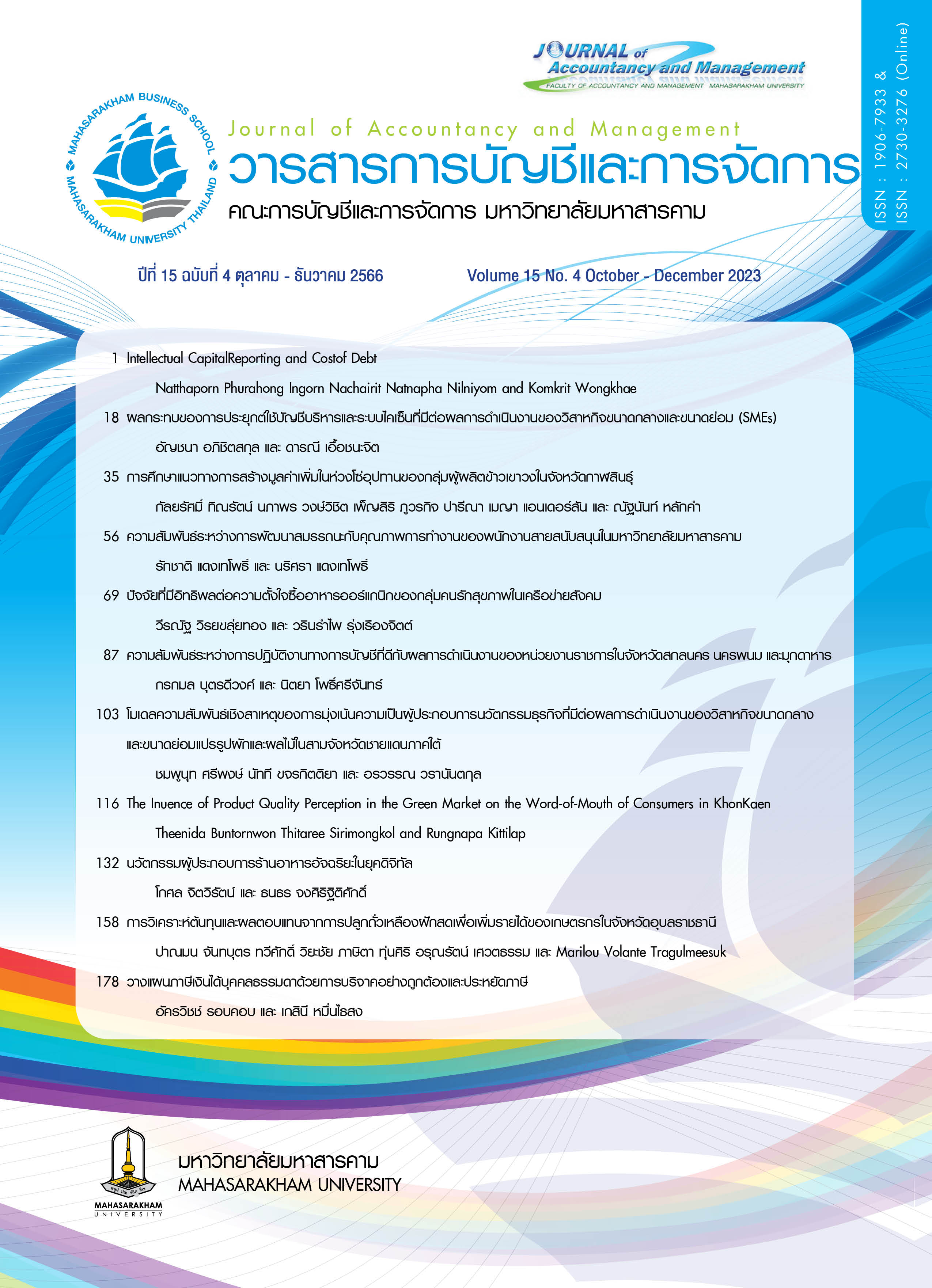โมเดลความสัมพันธ์เชิงสาเหตุของการมุ่งเน้นความเป็นผู้ประกอบการ นวัตกรรมธุรกิจ ที่มีต่อผลการดำเนินงานของวิสาหกิจขนาดกลางและขนาดย่อมแปรรูปผักและผลไม้ในสามจังหวัดชายแดนภาคใต้
Main Article Content
บทคัดย่อ
บทคัดย่อ
การศึกษานี้มีวัตถุประสงค์เพื่อ 1) ศึกษาระดับการมุ่งเน้นความเป็นผู้ประกอบการ นวัตกรรมธุรกิจ และผลการดำเนินงาน และ 2) พัฒนาและตรวจสอบโมเดลความสัมพันธ์เชิงสาเหตุการมุ่งเน้นความเป็นผู้ประกอบการ และนวัตกรรมธุรกิจ ที่มีต่อผลการดำเนินงานของวิสาหกิจขนาดกลางและขนาดย่อมผู้ผลิตผลิตภัณฑ์ผักและผลไม้แปรรูปในสามจังหวัดชายแดนภาคใต้ โดยเก็บรวบรวมข้อมูลด้วยแบบสอบถามผู้ประกอบการ จำนวน 327 คน วิเคราะห์ข้อมูลด้วยโปรแกรม SPSS ในการหาค่าสถิติพื้นฐาน และโปรแกรม LISREL 8.80 ผลการวิจัยพบว่า การมุ่งเน้นความเป็นผู้ประกอบการ นวัตกรรมธุรกิจ และผลการดำเนินงาน อยู่ในระดับมาก โมเดลความสัมพันธ์เชิงสาเหตุการมุ่งเน้นความเป็นผู้ประกอบการ และนวัตกรรมธุรกิจ ที่มีต่อผลการดำเนินงานของวิสาหกิจขนาดกลางและขนาดย่อมผู้ผลิตผลิตภัณฑ์ผักและผลไม้แปรรูปในสามจังหวัดชายแดนภาคใต้ กับข้อมูลชิงประจักษ์ ที่พัฒนาขึ้นสอดคล้องกับข้อมูลเชิงประจักษ์ ค่า c2=61.483, df=36, CFI=0.997, GFI=0.970, AGFI=0.934, SRMR =0.021, RMSEA=0.047 การมุ่งเน้นความเป็นผู้ประกอบการ ส่งผลทางตรงเชิงบวกต่อนวัตกรรมธุรกิจ นอกจากนี้นวัตกรรมธุรกิจส่งผลทางตรงเชิงบวกต่อผลการดำเนินงาน แต่การมุ่งเน้นความเป็นผู้ประกอบการ ส่งผลทางอ้อมเชิงบวกต่อผลการดำเนินงาน โดยมีนวัตกรรมธุรกิจเป็นตัวแปรส่งผ่าน ทั้งนี้ตัวแปรทั้งหมดสามารถอธิบายความแปรปรวนของผลการดำเนินงาน ร้อยละ 87.80 ดังนั้น ผู้ประกอบการวิสาหกิจขนาดกลางและขนาดย่อมควรให้ความสำคัญกับการมุ่งเน้นความเป็นผู้ประกอบการ เพื่อเสริมสร้างนวัตกรรมธุรกิจ ซึ่งนำไปสู่ผลการดำเนินงานที่ดีของธุรกิจ
Downloads
Article Details

อนุญาตภายใต้เงื่อนไข Creative Commons Attribution-NonCommercial-NoDerivatives 4.0 International License.
บทความที่ได้รับการตีพิมพ์เป็นลิขสิทธิ์ของวารสารการบัญชีและการจัดการ
ข้อความที่ปรากฏในบทความแต่ละเรื่องในวารสารวิชาการเล่มนี้เป็นความคิดเห็นส่วนตัวของผู้เขียนแต่ละท่านไม่เกี่ยวข้องกับมหาวิทยาลัยมหาสารคาม และคณาจารย์ท่านอื่นๆในมหาวิทยาลัยฯ แต่อย่างใด ความรับผิดชอบองค์ประกอบทั้งหมดของบทความแต่ละเรื่องเป็นของผู้เขียนแต่ละท่าน หากมีความผิดพลาดใดๆ ผู้เขียนแต่ละท่านจะรับผิดชอบบทความของตนเองแต่ผู้เดียว
เอกสารอ้างอิง
กระทรวงเกษตรและสหกรณ์. (2560). ยุทธศาสตร์เกษตรและสหกรณ์ระยะ20ปี (พ.ศ. 2560-2579) และแผนพัฒนาการเกษตรในช่วงแผนพัฒนาเศรษฐกิจและสังคมแห่งชาติ ฉบับที่ 12 (พ.ศ.2560-2564). กรุงเทพฯ : กระทรวงเกษตรและสหกรณ์.
กฤตชน วงศ์รัตน์. (2564). การพัฒนาโมเดลความสัมพันธ์เชิงสาเหตุของการมุ่งเน้นการเป็นผู้ประกอบการและความสามารถทางนวัตกรรมธุรกิจที่มีอิทธิพลต่อผลการดำเนินงานของอุตสาหกรรมการผลิตจังหวัดเพชรบุรี. วารสารบัณฑิตศึกษา มหาวิทยาลัยราชภัฏวไลยอลงกรณ์ ในพระบรมราชูปถัมภ์ ,15(2), 27-39.
ขจรศักดิ์ วงศ์วิราช บุญฑวรรณ วิงวอน และ ปิยกนิฏฐ์ โชติวนิช. (2563). วารสารชุมชนวิจัย มหาวิทยาลัยราชภัฏนครราชสีมา, 14(2), 121-134.
จันทนา พงศ์สิทธิกาญจนา และ ธงชัย พงศ์สิทธิกาญจนา. (2564). แนวทางการส่งเสริมความสำเร็จในการดำเนินงานของผู้ประกอบการชุมชนในภูมิภาคตะวันตก. วารสารวิชาการ RMUTT Global Business and Economics Review, 16(2), 89-102.
จุรีวรรณ จันพลา. (2559). การเสริมสร้างภาวะผู้นำเชิงนวัตกรรมของผู้ประกอบการ ในธุรกิจแปรรูปอาหาร. วารสารเทคโนโลยีภาคใต้, 9(1), 53-59.
นงเยาว์ อินทะนาม อำภาศรี พ่อค้า และกรกนก ดลโสภณ. (2563). การมุ่งเน้นความเป็นผู้ประกอบการที่มีผลต่อความสำเร็จของธุรกิจวิสาหกิจขนาดกลางและขนาดย่อมในจังหวัดกาฬสินธุ์. วารสารการบัญชีและการจัดการ มหาวิทยาลัยมหาสารคาม,12(4), 82-95.
วัชรพงษ์ อินทรวงศ์ และ ปัททมา สุริยกุล ณ อยุธยา. (2561). การศึกษาปัจจัยเชิงสาเหตุด้านภาวะผู้ประกอบการและนวัตกรรมที่มีต่อผลการดำเนินงานของกลุ่มวิสาหกิจชุมชนแปรรูปอาหารจังหวัดนครพนม. วารสารชุมชนวิจัย, 12(2), 101-117.
วิจักษณ์ สุวรรณเจริญ ราณี อิสิชัยกุล ทิพวรรณ บุณย์เพิ่ม และ อนุภาพ สมบูรณ์สวัสดี. (2559). การพัฒนาตัวแบบภาวะผู้นำการเปลี่ยนแปลง และนวัตกรรมที่มีอิทธิพลต่อการดำเนินงานทางธุรกิจของอุตสาหกรรมอาหาร. วารสารการจัดการสมัยใหม่, 14(2), 129-144.
วีระยุทธ พรพจน์ธนมาศ. (2565). การศึกษาเปรียบเทียบการตรวจสอบความเที่ยงตรงเชิงเนื้อหาของเครื่องมือวิจัยด้วยเทคนิค IOC, CVR, และ CVI. รังสิตสารสนเทศ, 28(1), 169-192.
สมพร ปานยินดี. (2558). ปัจจัยนำการมุ่งเน้นความเป็นผู้ประกอบการ และผลการดำเนินงานองค์การ. วารสารมหาวิทยาลัยราชภัฏมหาสารคาม (มนุษยศาสตร์และสังคมศาสตร์), 9(2), 47-58.
สุรเดช จองวรรณศิริ. (2562). การจัดการสู่องค์กรนวัตกรรม. กรุงเทพฯ : สำนักงานนวัตกรรมแห่งชาติ (องค์การมหาชน).
สำนักงานคณะกรรมการพัฒนาการเศรษฐกิจและสังคมแห่งชาติ. (2560). สรุปสาระสำคัญแผนพัฒนาเศรษฐกิจและสังคมแห่งชาติ ฉบับที่ 12. กรุงเทพฯ : สำนักงานคณะกรรมการพัฒนาการเศรษฐกิจและสังคมแห่งชาติ.
สำนักงานคณะกรรมการพัฒนาการเศรษฐกิจและสังคมแห่งชาติ. (2564). กรอบแผนพัฒนาเศรษฐกิจและสังคมแห่งชาติ ฉบับที่ 13. กรุงเทพฯ : สำนักงานคณะกรรมการพัฒนาการเศรษฐกิจและสังคมแห่งชาติ.
เสาวณี จันทะพงษ์ และ ทศพล ต้องหุ้ย. (2563, พฤษภาคม- มิถุนายน). เศรษฐกิจโลก เศรษฐกิจไทยหลังโควิด 19: โลกปฏิวัติโรค ยกเครื่องสู่อนาคตวิถีใหม่, บีโอที พระสยาม แม็กกาซีน, 3 (พฤษภาคม- มิถุนายน), ค้นเมื่อ 10 เมษายน 2566, จาก
https://www.bot.or.th/Thai/BOTMagazine/Pages/256303_CoverStory.aspx.
อาทิช แซ่ลี้. (2558). ศักยภาพการจัดการธุรกิจและคุณลักษณะของผู้ประกอบการที่ส่งผลต่อความสำเร็จของผู้ประกอบการไร่สำปะหลัง อำเภอบ่อพลอย จังหวัดกาญจนบุรี. วารสารมหาวิทยาลัยราชภัฏลำปาง, 4(2), 1-12.
Barney, J. (1991). Firm resource and sustained competitive advantage. Journal of Management, 17(1), 99-120.
Benazzouz, N. M. (2019). Entrepreneurial orientation and innovation intensity: A synthetic literature review. International Entrepreneurship Review, 5(2), 23-29.
Diamantopoulos, A., & Siguaw, J. A., (2000). Introduction to LISREL: A guide for the uninitiated. London : SAGE Publications, Inc,
Hair, J., Black, W., Babin, B., & Anderson, R. (2010). Multivariate data analysis: A global perspective (7th ed.). London : Pearson Education.
Kiyabo, K., & Isaga, N. (2020). Entrepreneurial orientation, competitive advantage, and SMEs’ performance: application of firm growth and personal wealth measures. Journal of Innovation and Entrepreneurship, 9(12), 1-15.
Kline, R. B. (2011) Principles and practice of structural equation modeling. New York : Guilford Press.
Lumpkin, G. T., & Dess, G. G. (1996). Clarifying the entrepreneurial orientation construct and linking it to performance. Academy of Management Review, 21(1), 135-172.
OECD - Organisation for Economic Cooperation and Development. (2005). Oslo manual: guidelines for collecting and interpreting innovation data, 3rd edition. Retrieved on Jul 5, 2022 from https://read.oecd-ilibrary.org/science-and-technology/oslo-manual_9789264013100-en#page3
Porter, M. E. (1985). Competitive Advantage Creating and Sustained Superior Performance. New York : The Free Press.
Rhee, J., Park, T., & Lee, D. H. (2010). Drivers of innovativeness and performance for Innovative SMEs in South Korea: Mediation of learning in orientation. Technovation, 30(1), 65-75.
Kaplan, R. S., & Norton, D. P. (1996). Translating strategy into action the balanced scorecard. Boston, MA : Harvard Business School Press.
Peng, S., Michael, S., & Xiaofeng, J. (2016). Entrepreneurial orientation and performance: Is innovation speed a missing link. Journal of Business Research, 69, 683-690.
Schumacker, R. E., & Lomax, R. G., (2010). A beginner’s guide to structural equation modeling. (3rd ed.). New Jersey : Lawrence Erlbaum Associates.


